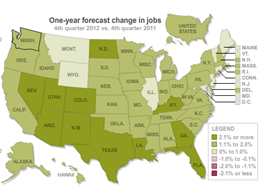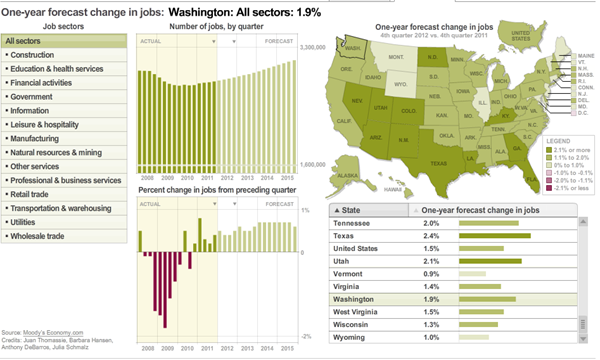Economic consulting firm Moody’s Analytics has forecasted U.S. job growth by geographic region and by industry. This interactive was updated March 7, 2012. We will update it each month.
This graphic shows actual job growth through fourth-quarter 2011 and Moody’s Analytics’ forecasted job growth for first-quarter 2012 through fourth-quarter 2015. It covers every state, the District of Columbia and 384 metro areas, broken down by fourteen industry sectors. The data are seasonally adjusted.
National, state and metro data through fourth-quarter 2011 are averages of monthly data from the Bureau of Labor Statistics‘ Current Employment Statistics (CES) survey.
The CES survey tracks the number of people employed full and part time by industry. It excludes proprietors, self-employed people, unpaid family or volunteer workers, farmworkers and domestic workers. Government employment covers only civilian workers. Employees are counted where they work, not where they live.
The CES survey is based on a sample of businesses and government agencies and is subject to sampling and nonsampling error. As a result, precise employment rankings are not possible for all geographies and industry sectors. Industry sector estimates, especially for smaller geographies or industries, can be volatile due to smaller sample sizes.
The data for first-quarter 2012 through fourth-quarter 2015 are forecasted by Moody’s Analytics. Demographic trends such as population growth, migration patterns, the age composition of populations, cost of living and business costs, and the global orientation of regional economies are key factors in its forecasts.
The forecasting model reflects the industry makeup of regions and the growth outlook for those industries. For example, the industrial Midwest takes into account the problems in the auto industry, and the relative success of the technology industry is reflected in forecasts for California’s Bay Area and Boston.
Moody’s Analytics’ model also takes into account policy decisions made by the Federal Reserve and the U.S. government.
click to interact with graph


Speak Your Mind